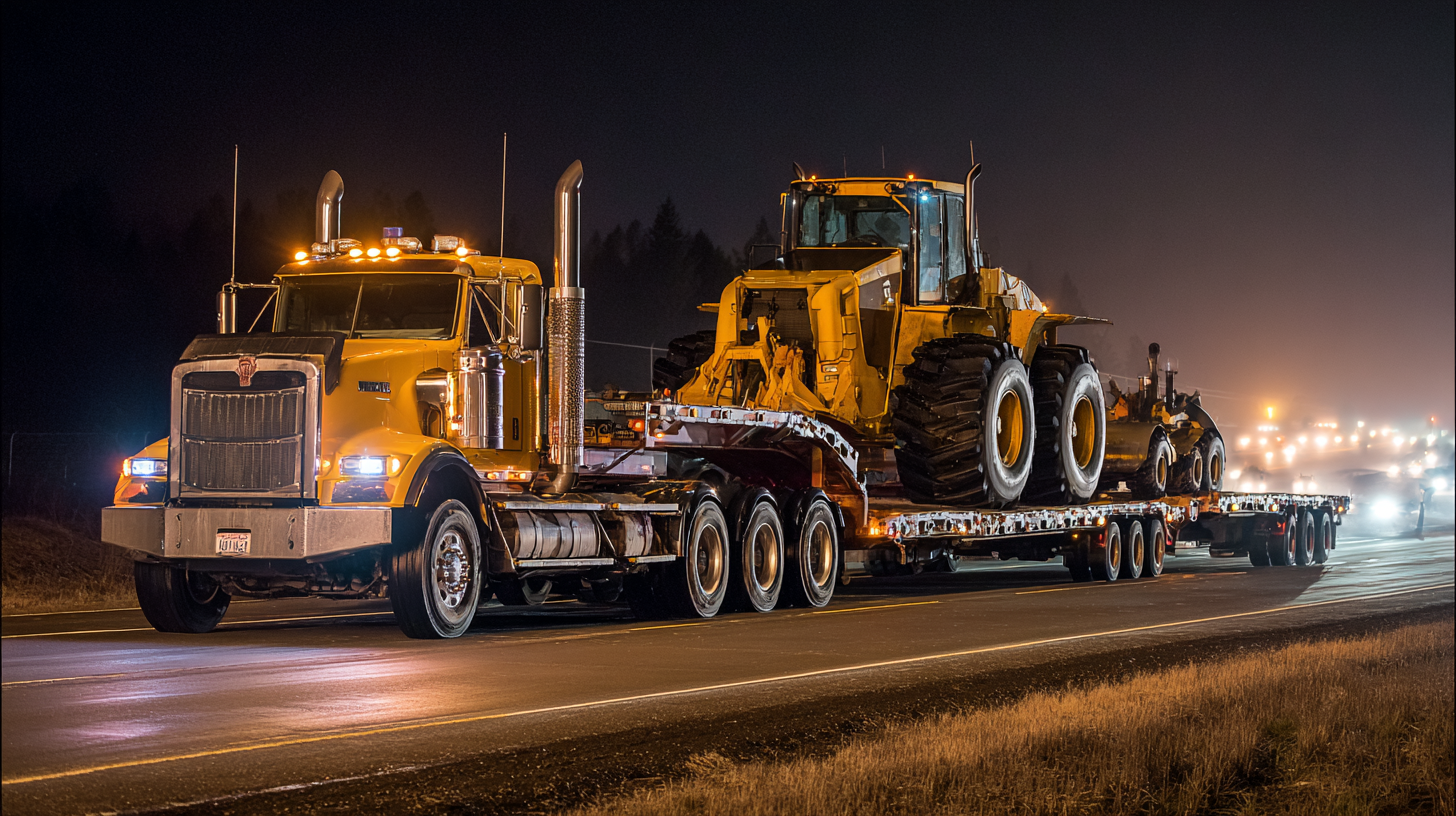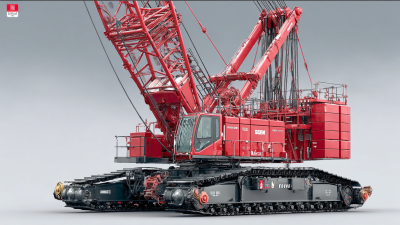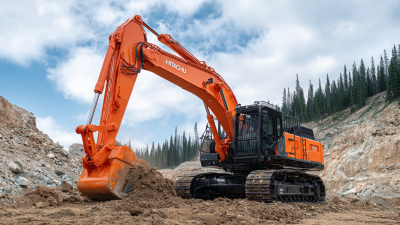Leave Your Message
- Phone
- E-mail
- Whatsapp
In the evolving landscape of construction and logistics, Heavy Equipment Hauling has emerged as a critical component driving efficiency and productivity. According to a recent report by Research and Markets, the global heavy equipment transportation market is expected to grow at a compound annual growth rate (CAGR) of 4.5%, highlighting a rising demand for effective transportation solutions in various industries. Efficient hauling strategies not only minimize operational costs but also enhance project timelines, making them indispensable for businesses aiming for competitiveness in a fast-paced market. As technology and innovation continue to shape the future of logistics, understanding and implementing top strategies for Heavy Equipment Hauling has never been more essential for organizations seeking to optimize their operations and ensure timely project delivery.

In the competitive landscape of global manufacturing, efficient heavy equipment hauling is crucial for maintaining productivity and reducing operational costs. Leaders in the industry must adopt strategic approaches to optimize their logistics processes.

When it comes to heavy equipment hauling, maximizing load efficiency is crucial for optimizing performance and cost-effectiveness. Properly calculating the optimal weight and volume plays a significant role in ensuring that your hauling operations run smoothly. A well-balanced load not only enhances fuel efficiency, helping in reducing operational costs, but also improves the safety and stability of the transport.
**Tip 1:** Always match axles, ratios, and loads to maximize fuel efficiency. By downspeeding—maximizing engine torque while minimizing RPMs—you can achieve better fuel consumption. This technique can often allow vehicles to carry heavier loads without compromising performance.
**Tip 2:** Understand the towing capabilities of your vehicles. Each type of vehicle has a unique towing capacity, influenced by engine specifications and design. Choosing the right equipment tailored to your specific hauling needs is essential.
Utilizing efficient hauling solutions not only enhances efficiency but also streamlines operations in various sectors including agriculture and construction. Exploring trends in chain sizes and advancements in transport technologies will further support operational effectiveness in the heavy equipment hauling arena.
Understanding the optimal weight and volume for hauling is crucial for maximizing load efficiency in heavy equipment hauling solutions. The following chart outlines the relationship between different load weights and corresponding volume capacities, providing insights into strategic planning for hauling operations.
In today's competitive landscape, integrating advanced logistics technologies is crucial for enhancing the efficiency of heavy equipment transport. Modern tools such as GPS tracking and route optimization software not only streamline operations but also reduce costs significantly. By employing real-time data analysis, companies can anticipate delays and make informed decisions to avoid potential disruptions.
Tip: Implementing GPS tracking allows for better visibility of the transport process, which can help in identifying bottlenecks and ensuring timely deliveries. This technology enables logistics managers to reroute trucks in real time, adapting to traffic conditions and enhancing overall efficiency.
Additionally, using automated scheduling systems can transform the way heavy equipment is managed. These systems aid in effectively coordinating shipments, ensuring that equipment is delivered precisely when and where it is needed. This not only saves time but also minimizes idle equipment and maximizes operational capacity.
Tip: Regularly updating your logistics software and training your staff on new technologies can lead to significant improvements in transport efficiency. Embracing innovation allows for more adaptable strategies in the ever-evolving heavy equipment hauling industry.
When it comes to international heavy equipment hauling, regulatory compliance is a critical factor that cannot be overlooked. Transport operators must understand the various rules and standards across different countries, especially those related to emissions and vehicle licensing. The European Union, for instance, is making strides towards stricter sustainability regulations, which will significantly impact how heavy equipment is transported.
The focus on emissions reduction, aiming for significant cuts by 2030, highlights the urgent need for operators to adapt their hauling strategies accordingly.
Tip: Ensure you are well-versed in the operator licensing requirements for your destination countries. This not only helps in adhering to local laws but also prevents costly delays. Staying informed about the latest emissions standards, especially within the EU, is equally important.
Another consideration is the environmental impact of trucking operations. With transport accounting for a significant portion of global emissions, incorporating sustainable practices is not just a regulatory requirement but also a competitive advantage.
Tip: Implement fuel-efficient routes and consider investing in alternative fuel options to comply with upcoming sustainability regulations. This proactive approach will aid in maintaining compliance while enhancing your company’s reputation in the international hauling market.
In the realm of heavy equipment hauling, the quest for fuel efficiency has emerged as a critical factor influencing cost-effective transport solutions. As industries face increasing pressure to reduce their carbon footprints, innovations in energy-efficient technologies are paving the way for more sustainable transport methods. The integration of advanced energy-efficient materials and methodologies is paramount, as they can drastically decrease energy demands and operational costs. Notable advancements such as compressed natural gas (CNG) vehicles and hydrogen fuel cell technologies showcase the potential of alternative fuels to not only streamline transport but also minimize environmental impacts.
Furthermore, the ongoing evaluation of transport performance and associated costs for zero-emission trucks reveals significant opportunities for the industry's evolution. Emphasizing hydrogen as a viable energy source, research indicates that transitioning to fuel cell-powered machinery can provide dual benefits: lowering greenhouse gas emissions and enhancing economic viability. As heavy equipment hauling adapts to these innovations, it is evident that sustainable practices driven by fuel efficiency represent a transformative strategy that can reshape the future of transportation, ensuring compliance with global sustainability goals while optimizing cost management.
| Strategy | Fuel Efficiency (%) | Cost Per Mile ($) | Load Capacity (tons) | Estimated Annual Cost ($) |
|---|---|---|---|---|
| Route Optimization | 15 | 2.50 | 25 | 25,000 |
| Regular Maintenance | 10 | 2.75 | 30 | 28,000 |
| Load Management | 12 | 2.20 | 20 | 18,000 |
| Driver Training | 20 | 2.00 | 35 | 30,000 |
| Fleet Upgrades | 18 | 2.40 | 40 | 35,000 |






